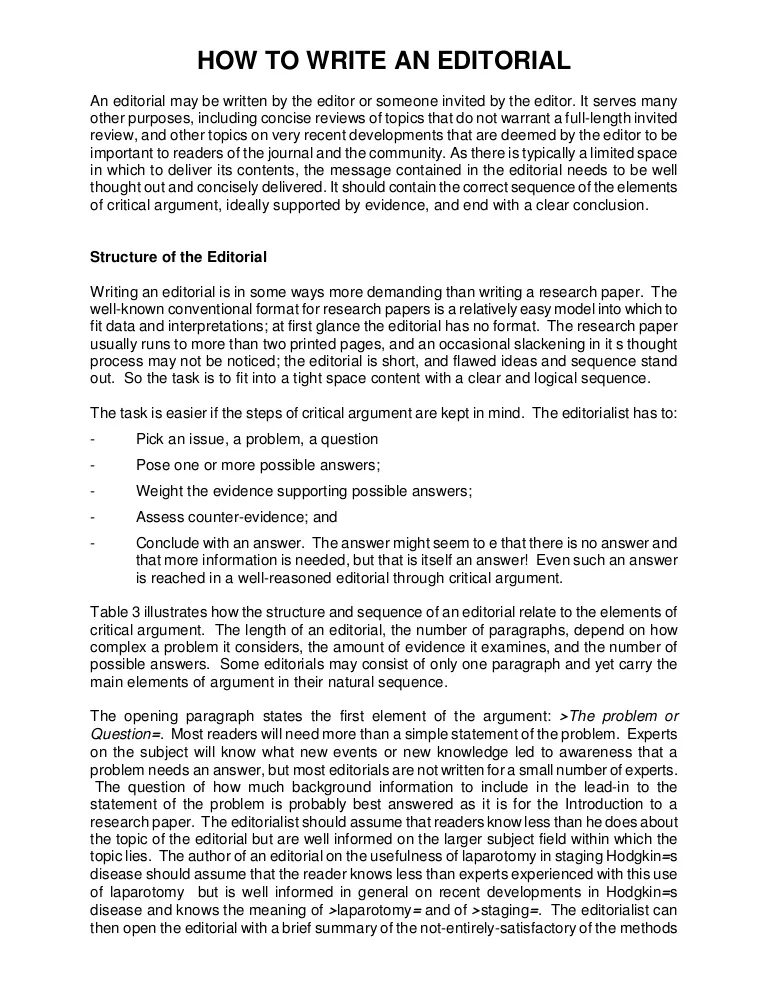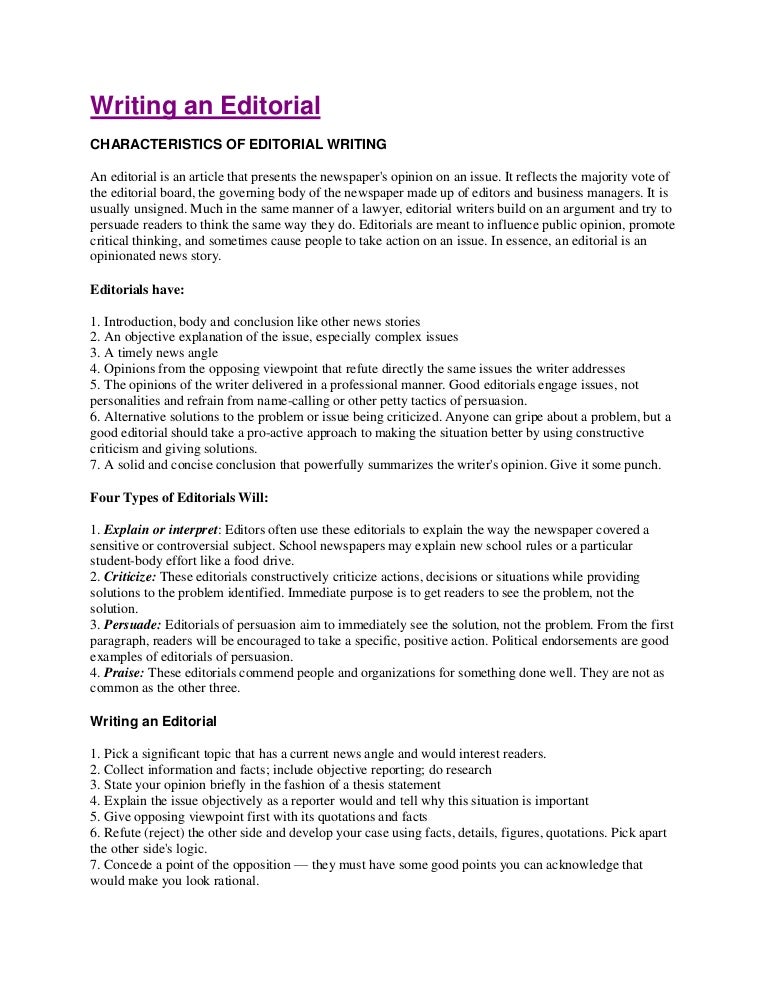
Editorial writing is a style that can be hard to explain as it is usually a unique mixture of fact and opinion. Viewing editorial examples is one of the most helpful ways to learn what the style should look like. Click on the document images to open and download the two examples of editorials provided here Feb 02, · You can write your editorial by yourself or with a group, but please submit only one editorial per student. Because editorial writing at newspapers is a Writing an Editorial 1. Pick a significant topic that has a current news angle and would interest readers. 2. Collect information and facts; include objective reporting; do research 3. State your opinion briefly in the fashion of a thesis statement 4. Explain the issue objectively as a reporter would and tell why this situation is important 5
Editorial Writing Examples | LoveToKnow
Writing an editorial is a great way to share your perspective or advocate for a cause to a wide audience. Effective editorial articles can raise awareness of an issue while also influencing other people's opinions on that topic.
Knowing how to write a strong editorial can allow you to make your voice heard, generate discussion in your community or take a stance on behalf of a group. In this article, we discuss what an editorial is, how to write editorial writing and tips for creating a good editorial.
An editorial is a short essay that shares an individual's opinion on a current event or social issue. The goal of a good editorial is to persuade the reader to consider your perspective and change their opinion, editorial writing. Editorials often focus editorial writing controversial issues with widely different viewpoints. Professors assign editorials in class to determine your skill at persuasive editorial writing, while writers at newspapers and magazines create editorials to make a claim or create discussion about their publication.
Your editorial should make a clear argument that reflects your stance and appeals to your audience. While the goal of all editorials is to share an opinion and persuade an audience, there are editorial style variations. The different types depend upon the goal of the article and can be divided into four categories:. Whether you are writing for a class assignment or a major publication, understanding the goal of your editorial will help guide your tone and the direction of your argument, editorial writing.
After determining the category of your editorial, editorial writing, you can begin to write confidently to influence an audience. Although people write editorials on a wide range of topics, most have the same basic components. All editorials need a clear stance and details to support that editorial writing. Good persuasive articles have the following elements:. Once you know the type of editorial you want to write and the basic components you need to include, editorial writing, you can begin the writing process.
If you are writing an editorial for a class or work assignment, refer back to the prompt frequently during the planning process. An editorial with specific classroom guidelines will likely be very different than an opinion piece published in a magazine or newspaper, editorial writing. Regardless of why you are writing your editorial, you can use these steps to create a strong foundation for a successful editorial paper:.
Since editorials are based on opinion, your topic should be arguable and have multiple points of view. Your essay will reflect your personal bias or the bias of the group you are representing, so you should expect some of your readers to disagree with your stance. You might select a controversial topic that involves politics to provoke conversation about your writing.
Regardless of the topic you choose, make sure that you can write about it passionately and focus on why others should agree with your perspective. As you decide what to write about, editorial writing, keep in mind that your topic should be specific. Keeping the scope of your editorial on a certain aspect of an issue will keep your argument strong and help the reader stay focused. A well-written editorial devotes multiple paragraphs to supporting one specific idea.
For example: A writer for a school newspaper might choose to write an editorial on the new school dress code. Instead of trying to criticize everything they editorial writing like about school, a writer can create a call-to-action by focusing on this one topical issue.
Whether their readers agree or disagree with the dress code, an editorial about a specific controversial topic will inspire others to engage in the issue. Related: The Key to Successful Speech Writing.
Even though an editorial is opinion-based, it is still important to provide your readers with well-researched evidence to back up your ideas. You can convince your readers of your credibility by demonstrating knowledge of what other prominent voices have to say on the topic. Researching your topic can also help you decide which particular stance you will take and create an article that contributes new ideas to the conversation.
After selecting and researching an issue, write an outline to keep your ideas organized and ensure that the main points of your editorial flow well. The introduction will always be at the beginning of the essay and the conclusion at the end, but you can organize your body paragraphs based on what format fits your essay the best.
List each main idea as its own paragraph, making sure to provide evidence for each idea. Once you finish the planning portion of writing your editorial, start to write by adding details to your outline. Some people prefer to start with the introduction, while others focus on the body of the paper first and write the introduction at the end. Try to write down as many ideas as you can at first, then go back and edit your paper. Getting started on a paper can be the most challenging part of the process for many writers.
If you find yourself having trouble beginning to write, look back on your research for inspiration, editorial writing. Related: Top 10 Study Skills and Techniques. Before submitting your editorial, proofread your own work to make sure you have created a professional, quality piece of writing. Many writers read their work aloud to check for tone and flow. Another popular proofreading technique is to read your paper backward, starting with the last sentence and moving to the introduction.
This process helps catch spelling and grammatical errors that you might not have seen the first time. You might also consider having a trusted friend or colleague read and summarize the main ideas of your paper for clarity.
A good editorial can focus on any topic, as long as you editorial writing make a strong case for your opinion and write with editorial writing audience in mind, editorial writing. Focus on why a editorial writing should care about your issue, as well as why someone might have a different opinion.
Understanding both sides of an issue will make your editorial interesting to a wide variety of audiences. Use these tips to make your editorial as convincing and relevant as possible:.
Your editorial needs to take a firm position on your chosen topic. Any time you editorial writing an editorial writing view, immediately explain why it is incorrect and why readers should agree with you instead. Convince readers to consider your ideas by displaying confidence in your stance, editorial writing. During the research process, see if there are any aspects to your issue that others have not yet discussed.
Editorial writing anyone can have an opinion, adding something new to a discussion will show that you have put careful thought into your piece. If you draw attention to an issue in an editorial, provide possible solutions to the problem. You want editorial writing avoid simply complaining so that the audience can find value in your editorial writing and consider taking action themselves.
Whenever possible, editorial writing, choose a editorial writing that you are passionate about. Your writing will reflect that you actually care about the issue, making your paper more interesting to read and more relevant editorial writing readers, editorial writing. Indeed Home. Find jobs. Company reviews. Find salaries. Upload your resume. Sign in. profile Sign in. Career Development. What editorial writing an editorial? Types of editorials.
Interpretive: An interpretive editorial explains and provides background information on an event or issue. This type of editorial aims to raise awareness and discuss how the topic is relevant to the reader. Critical: The critical format focuses on the various causes of a problem and suggests a solution.
For example, you might critique a policy that relates to your issue to advocate for a specific change. Persuasive: This type of editorial appeals directly to the reader and encourages them to take action.
The persuasive format focuses on the reader's ability to change a situation by following your advice. Praising: A praising editorial editorial writing appreciation for a person or organization based on their involvement in an issue. Parts of an editorial. Introduction: The introduction builds a reader's interest in the topic and gives an overview of the issue. Argument: The argument presents your opinion along with reasons why the audience should agree with you.
Evidence: The evidence supports your argument with facts, research or anecdotes. Counterargument: All editorial writers should establish credibility by presenting a fair review of the perspectives involved.
While a praising editorial might be mostly positive with a brief reference to an issue, a critical editorial needs to address the opposing perspective directly.
Refutation: After sharing the counter-argument with a reader, the writer must explain why that argument is editorial writing accurate or relevant. Refuting the counterargument allows you to promote your point of view while still seeming fair.
Conclusion: In the final paragraph of your editorial, summarize your point of view and remind the reader why they should care about this issue, editorial writing. How to write an editorial. Decide on a topic. Research your topic. Create an outline. Start to write. Tips for writing a good editorial. Be decisive. Offer new ideas, editorial writing.
Provide solutions. Focus on your interests. Related View More arrow right. Setting Goals To Improve Your Career Setting goals can help you gain both short- and long-term achievements.
Editorial writing
, time: 11:05How to Write an Editorial | Examples and Samples

An outline of a logical argument on a controversial subject. An editorial (persuasive) speech. A critique of peers’ speech and arguments. Analysis of editorials in local newspaper. A written editorial on a controversial subject of the student’s choice for publication submission Editorial writing is a style that can be hard to explain as it is usually a unique mixture of fact and opinion. Viewing editorial examples is one of the most helpful ways to learn what the style should look like. Click on the document images to open and download the two examples of editorials provided here An editorial is a newspaper article that presents the author’s point of view on different topics and issues. When assigned to write an editorial piece, you must understand the qualities and characteristics of an editorial that will appeal to the reader. Learn how to write an editorial with this complete guide
No comments:
Post a Comment